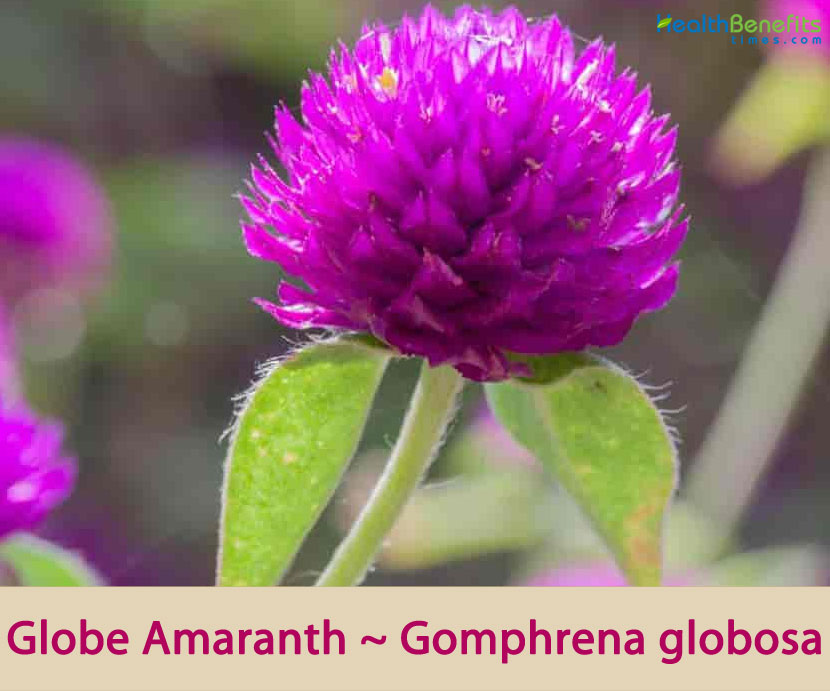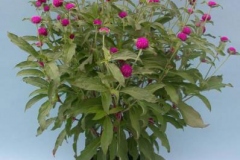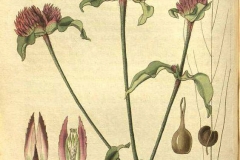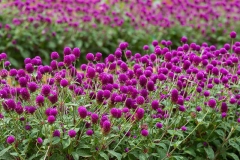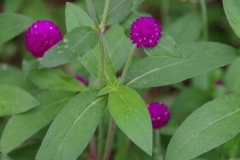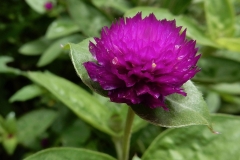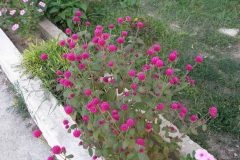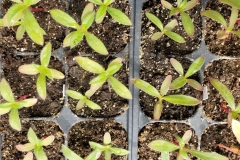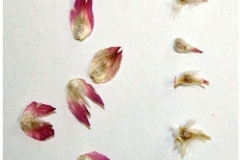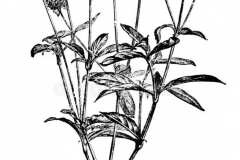| Globe Amaranth Quick Facts | |
|---|---|
| Name: | Globe Amaranth |
| Scientific Name: | Gomphrena globosa |
| Origin | Central America including regions Panama, and Guatemala |
| Shapes | Fruits are utricles, compressed, and indehiscent and is unopened at maturity and about 1.5–2.5 mm long |
| Taste | Sweet |
| Health benefits | Beneficial for colic, diabetes, cough, asthma, bronchitis, fatigue, headaches, sore throat, hoarseness, laryngitis, jaundice and treatment for body sore |
| Name | Globe Amaranth |
|---|---|
| Scientific Name | Gomphrena globosa |
| Native | Central America including regions Panama, and Guatemala, but is now grown globally |
| Common Names | Globe Amaranth, Gomphrena, Bachelor’s Buttons, Gentleman’s Button, Button, makhmali, vadamalli, rudrakshi hoova, Common globe amaranth, bozu, everlasting, pearly everlasting, perpetua, Christ’s cloak, St Francis’ cord |
| Name in Other Languages | Arabic: Dam aleashiq (دم العاشق) Armenian: Hndkakan ant’arram gndadzev (Հնդկական անթառամ գնդաձև) Assamese: Rakta mallikā (ৰক্তমল্লিকা), Kagaj-phul Azerbaijani: Başcıqlı qomfrena Belarusian: Gomfrena şaropodoʙnaja (гамфрэна шарападобная) Bengali: Botama phula (বোতাম ফুল), Gulmakhamal, Golkamal Chamorro: Buton agaga Chinese: Qian ri hong (千日紅) Chuukese: Wairhirhicha Colombia: Immortale Cuba: Flor de San Diego, inmortal, San Diego Czech: Pestrovka kulovitá Danish: Kugleamarant Dotyali: Supaaree phool (सुपारि फूल) Dutch: Kogelamarant English: Bachelor’s-button, Common globe amaranth, Globe-amaranth, bozu, everlasting, globe amaranth, pearly everlasting, Gomphrena, perpetua, Christ’s cloak, St Francis’ cord Finnish: Pyöröpallohäntä, pallohäntä French: Amarantine, amarantine globuleuse; gomphrena a tete globuleuse, marguerite, immortelle, immortelle violette, margrit, Immortelle pourpre German: Kugelamarant, Gemeiner Kugelamarant, Echter Kugelamarant Guyana:Tocoroho Haitian: Magerit Hawaiian: Lehua, lehua mau loa, lehua pepa, leihua Hindi: Gul-e-makhmal (गुले मख़मल) Honduras: Amor seco I-Kiribati: Te moteti, te motiti India: Gundi, botam phul Indonesia: Bunga kenop Italian: Amarantino perpetuino, falso trifoglio, gonfrena Japanese: Bozu, seniti-so, sennichikō (センニチコウ), sennichi-sô (センニチソウ) Kannada: Gāmphrina (ಗಾಂಫ್ರಿನ), Kempugonde (ಕೆಂಪುಗೊಂಡೆ), Nelrudrakshi (ನೆಲರುದ್ರಾಕ್ಷಿ), Bilirudrakshi (ಬಿಳಿರುದ್ರಾಕ್ಷಿ), Adake hoo gida, adike hoo, bilirudraakshi hoo, kaashigonde, kempu gonde, kempu gonge, mahaasahe, nelarudrakshi, rudrakshihoo Korean: Cheon il hong (천일홍) Laos: Saam pii Maithili: Supaaree phul (सुपारी फुल) Malay: Pokok Butang Ungu Malayalam: Vāṭārmalli (വാടാർമല്ലി), Vadamalli, wadapu Mangarevan: Po ai ura Manipuri: Petruklei, Chengkruk Maori (Cook Islands): Pōkai kura Marathi: Butamy, gomdo, jaapharee Marquesan: Erahua maita, erehua, pompon Marshallese: Abl‘ajtiiñ, ablajtiin, ebolastiñ Mizo: Chuailopar Nepali: Supaaree Phool (सुपारी फूल), Makhamalee Phool (मखमली फूल) Netherlands: Kogelamarant Niuean: Malila, malila kula, malila tea Norwegian: Kuleamarant Palauan: Botang Persian: گل تکمهای Pohnpeian: Kapunior, kapwunior, pahwis, pawehs Polish: Gomfrena kulista Portugal: Perpétua roxa, amaranto-globoso, gonfrena, perpétua Punjabi: Gaufarīnā (ਗੌਫ਼ਰੀਨਾ) Russian: Gomfrena (гомфрена), homfrena holovchataya (гомфрена головчатая) Samoan: Malila, melila Sindhi: گل مخمل Slovak: Gomfréna hlávkatá Spanish: Amarantina, Amor seco, Eterna, amaranto globoso; perpetua, pata de gallina, Inmortal, perpetuas, siempreviva, inmortales, manto de cristo, para todo, alumbra a las once, dondiego morado, sandiego, amaranto Redondo, amor seco Suriname: Staan vaste Swedish: Klotamarant Tahitian: Poe ura Tamil: Vāṭāmalli (வாடாமல்லி), Atiyomakacceti, atiyomakam, vatamalli, civappuvatamallikai, kalaimatakkannicceti, kanaiyakanni, kanaiyakannicceti, kurapakam, makacaka, makacakai, makacukkam, vatamallikai, vatanakappu, vatanakappucceti, vatappu Telugu: Bandu malli, erra pagada banti, rudraakshi, thella pedda goranta Thai: Bānmị̀rū̂roy (บานไม่รู้โรย) Tongan: Malila Tongarevan: Pōkai kula Turkish: Medine çiçeği Ukrainian: Homfrena holovchasta (гомфрена головчаста) Urdu: Gul-e makhmal (गुले मख़मल) USA/Hawaii: Boxu, lehua moa loa, lehua pepa |
| Plant Growth Habit | Erect, branched, pubescent, annual bedding plant |
| Soil | Adaptable to any soil type, even tolerates poor or clayey soils |
| Plant Size | 30-60 cm, with some cultivars reaching 90 cm tall |
| Stem | Erect, stout branched; branches slightly quadrangular with gray strigose hairs and is slightly inflated at nodes. |
| Leaf | Leaves are opposite, oblong-elliptic to oblong-obovate, 5-15 cm long and 2-6 cm wide, moderately pilose, petioles 1-1.5 cm long, the upper 1-2 sets of leaves are sessile. Young leaves are woolly-white and turn green with sparsely white hairs when mature |
| Flower | Flowers are numerous, densely crowded in globose heads; the heads are white, pink or purple, solitary, peduncled, 1.5 to 2 centimeters in diameter, subtended by 2 bracts |
| Fruit Shape & Size | Utricles, compressed, and indehiscent and is unopened at maturity and about 1.5–2.5 mm long |
| Seed | Shiny, ovoid, reddish brown, reniform, 1.5–2 mm wide and encased in a thick coating |
| Propagation | By Seed |
| Taste | Sweet |
| Plant Parts Used | Flowers |
| Culinary Uses |
|
Plant Description
Globe amaranth is an erect, branched, pubescent, annual bedding plant with a typical height of 30-60 cm, with some cultivars reaching 90 cm tall. It has a bushy subshrub appearance with a spread of 30-45 cm with branched stems. The plant is adaptable to any soil type and even tolerates poor or clayey soils. Stem is erect, stout branched; branches slightly quadrangular with gray strigose hairs and is slightly inflated at nodes and the plant has a bushy appearance. Leaves are opposite, oblong-elliptic to oblong-obovate, 5-15 cm long and 2-6 cm wide, moderately pilose, petioles 1-1.5 cm long, the upper 1-2 sets of leaves are sessile. Young leaves are woolly-white and turn green with sparsely white hairs when mature. They are available in various shades of green, from medium green to greyish- and bluish-green, sometimes with a purplish or silvery tinge.
| Leaf arrangement | Opposite/subopposite |
| Leaf type | Simple |
| Leaf margin | Entire |
| Leaf shape | Oblong |
| Leaf venation | Not applicable |
| Leaf type and persistence | Not applicable |
| Leaf blade length | 2 to 4 inches |
| Leaf color | Green |
| Fall color | Not applicable |
| Fall characteristic | Not applicable |
Flowers
Flowers are numerous, densely crowded in globose heads. Within the flower heads, the true flowers are small and inconspicuous. The heads are white, pink or purple, solitary, peduncled, 1.5 to 2 centimeters in diameter, subtended by 2 bracts. Bracteoles are 8 to 10 millimeters long, enclosing the flowers, lateral, keeled. Sepals, pubescent, 5, lanceolate, cleft at the tip, usually without staminodes. Ovary 1-celled, 1-ovuled; style short or long, stigmas 2. The most common color is magenta, but there are also white and pale mauve varieties.
Gomphrena globosa is an outcrossing species that is pollinated by butterflies, bees, and other insects. Floral volatiles likely play a significant role in the reproductive success of the plant by promoting the attraction of pollinators.
| Flower color | White; pink; purple; yellow |
| Flower characteristic | Showy |
Fruits
Fruits are utricles, compressed, and indehiscent and is unopened at maturity and about 1.5–2.5 mm long. Seeds are shiny, ovoid, reddish brown, reniform, 1.5–2 mm wide and encased in a thick coating.
| Fruit shape | No fruit |
| Fruit length | No fruit |
| Fruit cover | No fruit |
| Fruit color | Not applicable |
| Fruit characteristic | Inconspicuous and not showy |
Health benefits of Globe Amaranth
Listed below are some of the popular health benefits of Globe Amaranth
1. Balances Blood Pressure
Oils in amaranth bloom have been appeared to help counteract and treat those with hypertension and cardiovascular sickness. Normal consumption of amaranth can decrease cholesterol levels and lower pulse. An infusion of amaranth blossoms additionally helps the body’s immune system, lessening defenselessness to viruses.
2. Prevents Grey Hair
Regular consumption of amaranth tea has additionally been appeared to decrease the greying of the hair. An infusion of Amaranth Tea is smooth and stimulating, with an unadulterated, fresh and quietly rich aroma. Enjoy the enchanting sight as the infusion turns from delicate pink to a deep purple. Also a great expansion to mixed drinks and jellies for its wonderful shading.
3. Anti-Bacterial Properties
It has wonderful anti-bacterial properties. Whole plant methanol extract has been clinically proven to have anti-bacterial properties against gram positive bacteria that include Bacillus Cereus and Staphylococcus Aureus. It has anti-bacterial properties against gram negative bacteria that include Escherichia Coli and Salmonella Typhi.
4. Anti-Fungal Properties
The methanolic extract has anti-fungal properties against fungal strains that include Candida Albicans, Aspergillus Niger and Saccharomyces Cerevisiae.
5. Antioxidant Properties
The methanolic extract of the whole plant showed significant anti-oxidant properties. Gomphrena globosa tea is very famous in many places and is consumed for its wonderful antioxidant properties.
6. Detoxifying & Purifying Properties
Gomphrena globosa is truly a detoxifying herb and helps get rid of toxins and helps purify our body. Apart from the mentioned medicinal uses, it has been traditionally used for treating gall stones, nose bleed, cough and oliguria (low amount of urine production).
Traditional uses and benefits of Globe Amaranth
- Flowers of G. globosa are used in traditional medicine to treat colic, diabetes and problems with the prostate and reproductive systems.
- It is also used to treat a variety of respiratory problems, including cough, asthma and bronchitis, and problems with the kidneys and urinary system.
- It contains vitamin C and E and thought to reduce fatigue and slow aging.
- It has been used to treat stomach upset, and has even been used to treat colic in babies.
- Globe amaranth tea is said to help stop greying of hair, and the amino acids may help to delay hair loss.
- Globe amaranth tea has also been sued for centuries to counter high blood pressure.
- Oils contained in the flowers are helpful in lowering blood pressure, and while they shouldn’t be used instead of blood pressure meds.
- It can also help you to cure chronic inflammation.
- Globe Amaranth herbal Tea is an excellent anti-inflammatory that efficiently combats headaches, sore throat, hoarseness, cough, bronchitis, laryngitis, clears the voice, and relieves symptoms of asthma.
- It is also a tea that is drunk regularly to prevent cancer, reduces bad cholesterol and acts as a natural tranquilizer.
- Globe Amaranth tea is used for a baby gripe, oliguria, cough and diabetes.
- It is also known for helping to relieve cough, shortness of breath, and enhance vision.
- It is commonly consumed for the treatment of several respiratory inflammatory conditions, such as bronchial asthma, acute and chronic bronchitis or whooping cough.
- Decoction of dried material or inflorescences is used for bronchial asthma, acute and chronic bronchitis, and whooping cough.
- Decoction of fresh plant used to wash sores.
- Flower decoction are used for inflammation of the eyes, difficulty urinating, headaches, and dysentery.
- In Myanmar, decoction of plant used for cough.
- In the Guianas, whole plant infusion of the white-flowered variant used as diabetes remedy.
- Warm infusion of leaf is used as sudorific.
- Globosa leaves and flower are used as a folk remedy for oliguria, heat and empacho, hypertension, antioxidant, antimicrobial, cough, diabetes, kidney problems, hoarseness, bronchitis, jaundice, high cholesterol, and other respiratory disorders.
- It is also used as crushed paste of leaves, which is applied to the affected part and covered with the leaves of the same plant, as a treatment for body sore.
Home Remedies Using Globe Amaranth
- Globe Amaranth Tea: To make the tea, boil water and add either fresh flowers or the dried ones and let them steep for a few minutes, strain and drink. If you prefer you can sweeten with honey too. This tea is full of antioxidants, vitamins and minerals. It is very good for diabetics and pressure patients. It also has a calming effect and is wonderful in reducing stress.
- For Wounds: Since it has anti-microbial properties, the whole plant can be ground and applied as a poultice. This poultice is very effective and helps heal wounds very quickly.
- For Skin: Tea or the infusion of the fresh flowers can be used just like rose water for skin care. Since it is rich in antioxidants it will greatly prevent skin ageing. You can use it to mix dry ingredients in face packs; can be used in creams and lotions too.
Other Facts
- Gomphrena globosa flowers are a source of betacyanins which are used as additives in the food and cosmetic industries and as a natural purple-red food dye.
- In Hawaii, it is commonly used in long-lasting leis since it retains its shape and color after drying.
- In Nepal, the flower also known commonly as makhamali ful and is used to make a garland during Bhai Tika, last day of Tihar.
- This plant is popular in landscape design and cutting gardens for its vivid colors and color retention.
References:
https://www.itis.gov/servlet/SingleRpt/SingleRpt?search_topic=TSN&search_value=20804#null
http://www.hear.org/pier/species/gomphrena_globosa.htm
https://npgsweb.ars-grin.gov/gringlobal/taxon/taxonomydetail?id=17860
http://www.missouribotanicalgarden.org/PlantFinder/PlantFinderDetails.aspx?kempercode=a115
https://www.cabi.org/isc/datasheet/25617
http://www.theplantlist.org/tpl1.1/record/kew-2829209
https://en.wikipedia.org/wiki/Gomphrena_globosa
http://www.plantsoftheworldonline.org/taxon/urn:lsid:ipni.org:names:327333-2
http://www.flowersofindia.net/catalog/slides/Gomphrena.html
https://gd.eppo.int/taxon/GOMGL
https://ijrap.net/admin/php/uploads/2378_pdf.pdf
https://plants.usda.gov/home/plantProfile?symbol=GOGL


